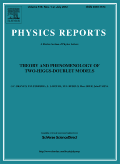
PHYSICS REPORTS-REVIEW SECTION OF PHYSICS LETTERS
metrics 2024
Elevating insights in physics and astronomy.
Introduction
Physics Reports - Review Section of Physics Letters is a prestigious journal published by Elsevier, dedicated to providing comprehensive and insightful reviews in the field of physics and astronomy. With its ISSN 0370-1573 and E-ISSN 1873-6270, this esteemed publication features high-quality content that spans a converged timeline from 1971 to 2024. Recognized as a Q1 journal in the Physics and Astronomy category for 2023, it holds a remarkable Scopus ranking of #2 out of 243, placing it firmly in the top 1% of its field. The journal serves as a pivotal resource for researchers, professionals, and students alike, facilitating the dissemination of critical analyses and contemporary developments in physics. While it is not open access, its rigorous peer-reviewed articles ensure that students and researchers remain at the forefront of scientific inquiry. With its impactful contributions, Physics Reports continues to enhance the knowledge base and push forward the boundaries of physics research.
Metrics 2024
 6.43
6.43 23.90
23.90 25.70
25.70 318
318Metrics History
Rank 2024
Scopus
IF (Web Of Science)
JCI (Web Of Science)
Quartile History
Similar Journals

TECHNICAL PHYSICS
Exploring Innovations in Theoretical and Applied PhysicsTECHNICAL PHYSICS, published by PLEIADES PUBLISHING INC, is a prestigious journal that has been serving the scientific community since its inception in 1996. With a focus on the diverse realms of physics and astronomy, this journal is committed to publishing pioneering research that spans various aspects of theoretical and applied physics. Though currently categorized in the Q3 quartile for the year 2023, TECHNICAL PHYSICS holds considerable merit with a Scopus ranking of #56 out of 81 in its field, positioning it within the 31st percentile. The journal aims to provide a platform for researchers, professionals, and students to disseminate their findings and foster collaboration within the global physics community. While it does not currently offer open access, the journal remains a vital resource for those seeking to stay informed of the latest advancements and trends in technical physics. Based in the heart of New York, it continues to contribute to the evolution of this dynamic field.
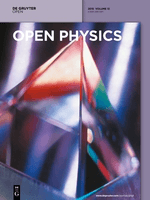
Open Physics
Connecting minds, sharing breakthroughs in physics.Open Physics, published by DE GRUYTER POLAND SP Z O O, is a leading open access journal dedicated to advancing the field of physics and astronomy. Established in 2015, this journal not only promotes the dissemination of innovative research but also emphasizes accessibility, allowing researchers, professionals, and students alike to freely engage with the latest advancements in various physics disciplines. With an impact factor that positions it within the Q3 category of the broader physics and astronomy community, Open Physics currently holds a respectable ranking of #102 out of 243 journals in its field according to Scopus, placing it in the 58th percentile. The journal encourages rigorous scholarship and the sharing of knowledge within a collaborative environment. Based in Germany, with its editorial office located in Warsaw, Poland, Open Physics is dedicated to fostering international dialogue and interdisciplinary research, making it an essential resource for those shaping the future of physical sciences.
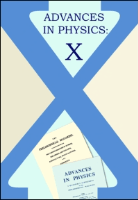
Advances in Physics-X
Unveiling New Horizons in Scientific ResearchAdvances in Physics-X is a premier open-access journal published by Taylor & Francis Ltd, dedicated to advancing the frontiers of knowledge in the field of Physics and Astronomy. Since its inception in 2016, the journal has established itself as a vital platform for researchers and professionals, showcasing innovative research and cutting-edge theories that influence a broad array of sub-disciplines within physics. With an impressive impact factor and ranked in the 94th percentile among its peers, it resides in the Q1 category for Physics and Astronomy (miscellaneous), indicating its significant contributions to the academic community. Located in the United Kingdom, the journal encourages open access to foster wider dissemination and visibility of scholarly works, aligning with contemporary academic trends that prioritize global knowledge sharing. The ongoing commitment to publishing high-quality research ensures that Advances in Physics-X remains an essential resource for students, industry experts, and academics alike, helping to shape the future of physics research through collaboration and innovation.

Jordan Journal of Physics
Navigating the Frontiers of Physics and AstronomyJordan Journal of Physics is a pivotal scholarly platform published by YARMOUK UNIVERSITY, DEANSHIP RESEARCH & GRADUATE STUDIES, dedicated to the field of physics and its applications. Established in 2008, this journal serves as a crucial avenue for disseminating quality research and insights in various subfields of physics and astronomy. As a publication in the Q4 category per the 2023 metrics, the journal, while currently placed in the lower quartile, offers a unique opportunity for emerging researchers to contribute their findings. With an ISSN of 1994-7607 and a commitment to fostering academic discourse, the Jordan Journal of Physics provides access to original research articles, reviews, and case studies aimed at enriching knowledge and innovation. While it does not presently offer open access, efforts are underway to expand its reach and visibility in the global academic context. Researchers and scholars will find this forum to be an essential resource for advancing their work and connecting with a community dedicated to exploration and understanding of the fundamental principles that govern our universe.

European Physical Journal Plus
Empowering Research with Open Access to KnowledgeThe European Physical Journal Plus, published by Springer Heidelberg, is a reputable open-access journal that serves as a vital platform for innovative research across various disciplines, including physics, astronomy, and chemical engineering. With an impressive impact factor reflected by its Q2 ranking in both Fluid Flow and Transfer Processes and Physics and Astronomy (Miscellaneous) categories, this journal plays a crucial role in disseminating high-quality research findings. Since its inception in 2011, it has fostered interdisciplinary collaboration and encourages the exploration of fundamental principles and applications. The journal also boasts a respectable Scopus rank, indicating its solid influence and reach within the scientific community. Researchers, professionals, and students alike will find the journal to be an essential resource for staying abreast of advancements and trends in these dynamic fields, while its open-access model ensures that valuable insights are accessible to a broader audience.

ACTA PHYSICA SINICA
Bridging Ideas in Physics for a Brighter FutureACTA PHYSICA SINICA is a prominent journal published by the Chinese Physical Society, dedicated to the dissemination of groundbreaking research in the field of physics and astronomy. Established in 1993, this journal has consistently contributed to the scientific community by publishing high-quality articles that cover a wide range of topics within general physics and related disciplines. Although currently classified in Q4 of the physics and astronomy category by Scopus, ACTA PHYSICA SINICA plays an important role in fostering collaboration and communication among researchers in China and around the world. With a substantial readership, this journal is poised to remain a valuable resource for professionals, researchers, and students alike. By providing in-depth analysis and insights, it aims to advance the understanding and application of physical principles in various technological and scientific advancements. The journal is accessible via subscription, ensuring that contributors and readers can engage with the evolving landscape of physics research. For more information, visit the publisher's website.
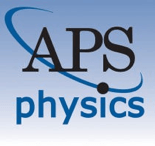
Physical Review X
Fostering Collaboration in Cutting-Edge SciencePhysical Review X is a premier open-access journal published by the American Physical Society, dedicated to advancing the frontiers of knowledge in the field of physics and astronomy. Established in 2011, it has quickly gained recognition for its rigorous peer-review process and high-quality research contributions, achieving an impressive impact factor that solidifies its position in the top quartile (Q1) of its category for 2023. With a Scopus rank of #8 out of 243 in the general physics and astronomy division, it stands in the 96th percentile, showcasing its vital role in disseminating groundbreaking discoveries and theoretical insights across diverse physics domains. As an open-access journal, Physical Review X ensures that research is freely accessible to a global audience, fostering collaboration and innovation. Researchers, professionals, and students alike are invited to explore its extensive archive and contribute to the ongoing dialogue in the scientific community, empowering the next generation of physicists and astronomers.
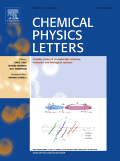
CHEMICAL PHYSICS LETTERS
Pioneering Insights in Physical and Theoretical ChemistryCHEMICAL PHYSICS LETTERS, published by Elsevier, is a prestigious journal that has been at the forefront of advancing knowledge in the fields of physical and theoretical chemistry and physics since its inception in 1967. With an impressive impact factor reflective of its high-quality research output, this journal holds Q2 quartile rankings in both the Physical and Theoretical Chemistry and Physics and Astronomy categories for 2023. It is recognized as a key platform for disseminating groundbreaking findings, with Scopus rankings placing it within the top 76th and 66th percentiles in its respective categories. Researchers and professionals benefit from its insightful contributions and rigorous peer-review process, making it an essential resource for those engaged in cutting-edge chemical physics studies. Although the journal is not open access, it remains accessible through various institutional subscriptions, ensuring that a wide audience can explore its wealth of knowledge. Located in Amsterdam, Netherlands, the journal continues to drive innovation and collaboration across diverse scientific disciplines.

MOMENTO-Revista de Fisica
Bridging Knowledge Gaps in Physics and BeyondMOMENTO-Revista de Fisica is a distinguished academic journal published by UNIV NACL COLOMBIA, FAC SCI, based in the vibrant academic landscape of Colombia. With an ISSN of 0121-4470 and an E-ISSN of 0121-4470, this Open Access journal has been a pivotal platform for disseminating research since its shift to Open Access in 2012. It primarily serves researchers, professionals, and students interested in a diverse range of fields such as Electronic, Optical and Magnetic Materials, Geophysics, History and Philosophy of Science, and Physical and Theoretical Chemistry. With an evolving focus that spans from 2019 to 2024, MOMENTO contributes significantly to the understanding of contemporary challenges and advancements in physics and its interdisciplinary applications. Despite its current Q4 rankings in several categories and Scopus rankings indicating growth areas, the journal plays a crucial role in nurturing a scholarly dialogue in less represented topics within the sciences. By bridging gaps in knowledge and fostering new ideas, MOMENTO-Revista de Fisica continues to attract authors and readers committed to pushing the boundaries of research.
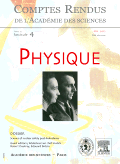
COMPTES RENDUS PHYSIQUE
Empowering Global Dialogue in Physics ResearchCOMPTES RENDUS PHYSIQUE, published by the esteemed Académie des Sciences, is a prestigious open access journal dedicated to the advancement of knowledge in the field of Physics and Astronomy. Since its inception, it has established a significant presence in the academic community, achieving an impressive Q2 ranking for the year 2023 in its category and holding a respectable 116th place within the Scopus rankings for General Physics and Astronomy. COMPTES RENDUS PHYSIQUE not only serves as a platform for high-quality research articles, reviews, and discussions but also strives to facilitate the dissemination of crucial scientific findings to a global audience, reflecting its commitment to open access since 2020. Based in Paris, France, the journal aims to bridge the gap between theoretical research and practical applications, supporting researchers, professionals, and students who seek to stay at the forefront of technological and scientific innovation. With its comprehensive coverage from 2002 to 2024, COMPTES RENDUS PHYSIQUE remains a vital resource for anyone engaged in the ever-evolving landscape of physics.